Indian Army’s Operation Riddle, targeting Lahore and Kasur on 6 September 1965, created panic in the ranks of the Pakistan Army. As expected, Pakistan rushed to stop the Indian onslaught and pumped in reinforcements from other sectors including Chhamb, where the Pakistan Army offensive was already waning. Among other measures to counter India, Pakistan Premier Ayub Khan ordered the Pak CAS, Air Marshal Nur Khan, to target and eliminate the IAF offensive capability, so that IAF would not be able to support the Indian Army on the Lahore front.
Nur Khan came to the conclusion that PAF had to act fast and take ascendancy over IAF before the IAF targeted PAF airfields in a dedicated counter air effort. He set in motion PAF’s Warplan No. 6, which called for pre-emptive strikes against the frontline IAF bases of Pathankot, Halwara, Adampur, Jamnagar, as well as the IAF radars at Amritsar, Ferozpur and Porbandar. Nur Khan anointed the evening of 6 September for these coordinated strikes to destroy the IAF’s core air defence and striking power. PAF launched these raids as per the warplan against IAF targets in the evening of 6 September 1965.
While the PAF’s Pathankot raid was a success, other strikes failed due to staunch IAF defensive operations, especially at Halwara, where the PAF’s most well-regarded pilot Sqn Ldr Sarfraz Rafiqui was shot down with his wingman. Given the surprise and odds in favour of the PAF, the failure of Adampur and Halwara air strikes did not go well with the PAF. Raids on the Amritsar, Porbandar and Ferozpur radars, as well Jamnagar airfield, were also a failure.
Post 6 September, the PAF stopped all daylight bombing missions into India.
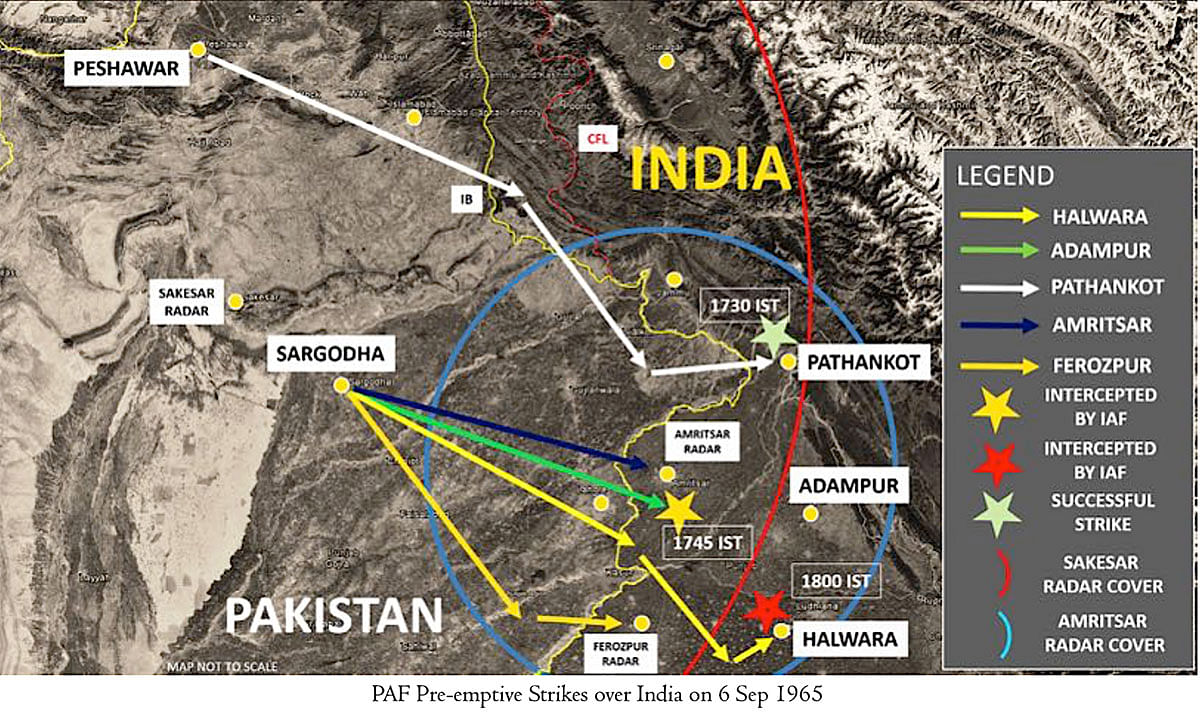
The IAF CAS, Air Mshl Arjan Singh, decided to give the PAF a befitting reply by sanctioning all-out strikes against PAF bases on 7 September 1965.
Late into the night of 6 September 1965, coded IAF Command tasking orders for authorising multiple strikes against the PAF on 7 September were issued to the bases at Agra, Adampur and Halwara. The main components of the attack force were Canberra Bombers (5 Sqn) from Agra, Mysteres (1, 8 Sqn) from Adampur and Hunters (7 and 27 Sqn) from Halwara. In spite of the chaos due to the Pakistan Army’s Special Service Group (SSG) paratrooper drops over Adampur and Halwara, as well as the incessant B57 night bombing raids over these airfields on the intervening nights of 6/7 September, these bases buzzed with activity during late night/early morning, preparing and arming their aircraft and holding elaborate mission briefs. Though the intelligence was limited on the PAF’s disposition, all IAF air warriors at these bases were motivated and primed to hit back at the PAF. They wanted to pay them back in kind — tit for tat!
Their primary target was the Sargodha Complex.
Sargodha airbase is located in the Punjab province of Pakistan near the Kirana Hills across the river Chenab. It was commissioned in 1959, when the newly acquired F86F Sabre jets of the PAF’s 5, 11 and 16 Squadrons were transferred to the base. It became the headquarters of PAF’s Central Command. During the 1965 war, elements of PAF’s 17, 18, 19 Sqns also moved to Sargodha from Mauripur for the pre-emptive strike build up phase on 5/6 September. It also deployed 2 and 20 Sqns of the PAF’s T33 aircraft.

Sargodha had newly-constructed blast pens, which were considered bomb-proof for the most part. In this labyrinth of pens and taxiways, the Sabres and other PAF aircraft were parked expansively, immune to enemy munitions. Sargodha was also home to the Flight Leaders’ School (FLS), the predecessor of the present PAF Combat Commanders School (CCS). In 1965, it had a cross runway 14/32 and 06/24, which facilitated rapid launch and recovery of fighter jets. It also housed the most advanced command and control centre available in the subcontinent at the time with jam-proof lines and air defence radars deployed at Sakesar and Rahwali. Allied airfields around Sargodha (main) were Chhota Sargodha (towards West), Bhagtanwala (towards East) and Waghowal (towards North). These satellite fields, along with the main runway at Sargodha were known as the ‘Sargodha complex’ and between them housed the highest density of PAF war fighting assets. At the peak of its operational capability, the Sargodha complex was home to nearly 80 Sabre jets and five F104 Starfighters.
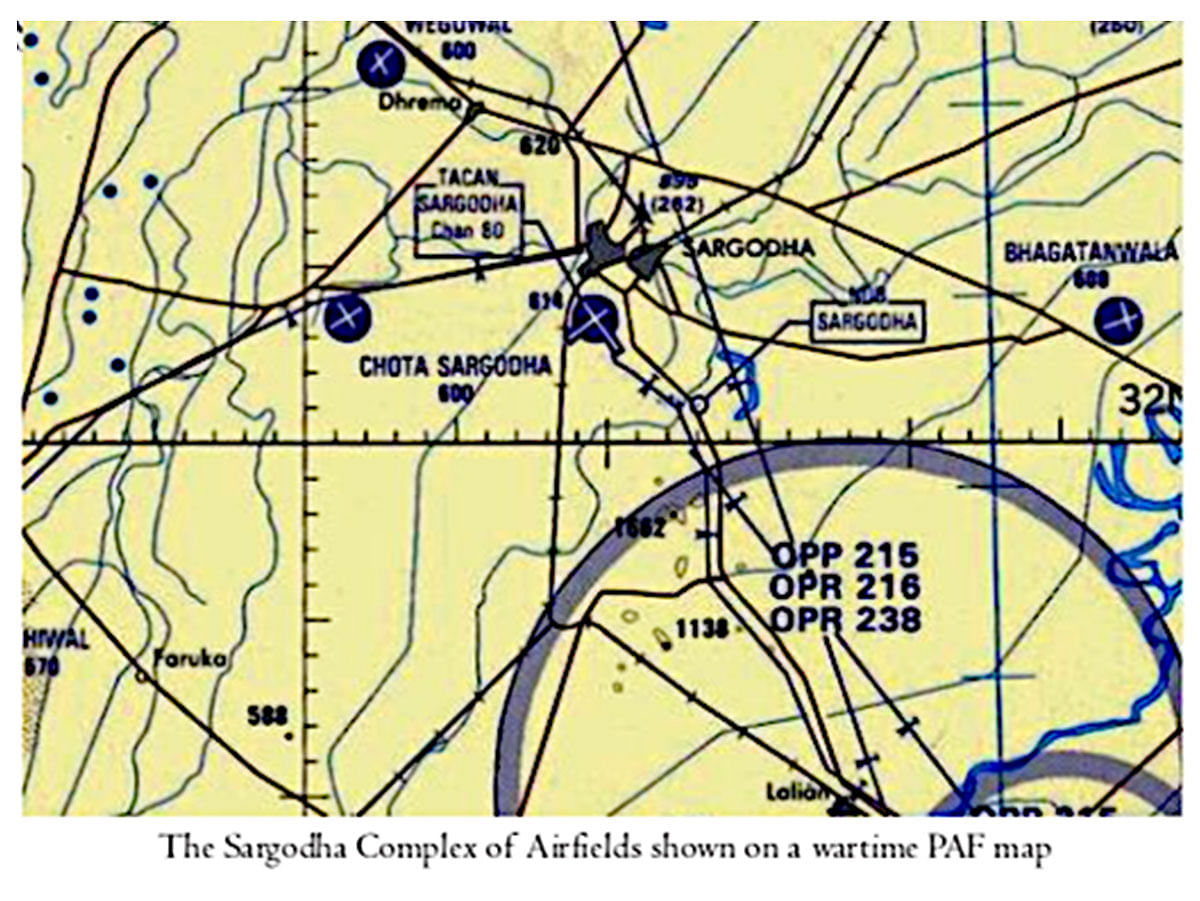
A CAP of two to four Sabres, and at least one Starfighter, elaborately defended the Sargodha complex at all times. One pair of Sabres was deployed at 10 miles to 25 miles as the inner defence ring, while another pair maintained overhead/ adjacent to the base at 10,000 feet. The Starfighter was deployed at a height of 15-20,000 feet as the outer defence ring beyond 25 miles. Point defence at the base was provided by the L60 40mm Bofors anti-aircraft radar controlled (RC) guns of Pakistan Army’s No. 14 Regiment. In addition, 0.5 inch Browning M2 and 7.62mm Rheinmetal MG3 anti-aircraft machine guns littered the airfield at strategic locations.
Early warning to Sargodha was provided by the high power Early Warning (EW) and Ground Controlled Interception (GCI) radar at Sakesar. Sakesar is a 4,992 feet mountain peak on the outer fringes of Punjab’s Soon valley. In 1962, as part of the SEATO treaty, a US-made, state of the art FPS-6 radar, with a peak power of 3.5 MW, was commissioned by PAF as part of its Air Defence Ground Environment System (ADGES), which with a range of 350 km could look deep inside Punjab and J&K on the Indian side. It thus provided comprehensive warning to the PAF fleet against IAF activity. The radar could pick medium- to high-altitude IAF targets across the IB, as well as low- level ingressing IAF strikers down to 200 feet at 30–50 km on most occasions.
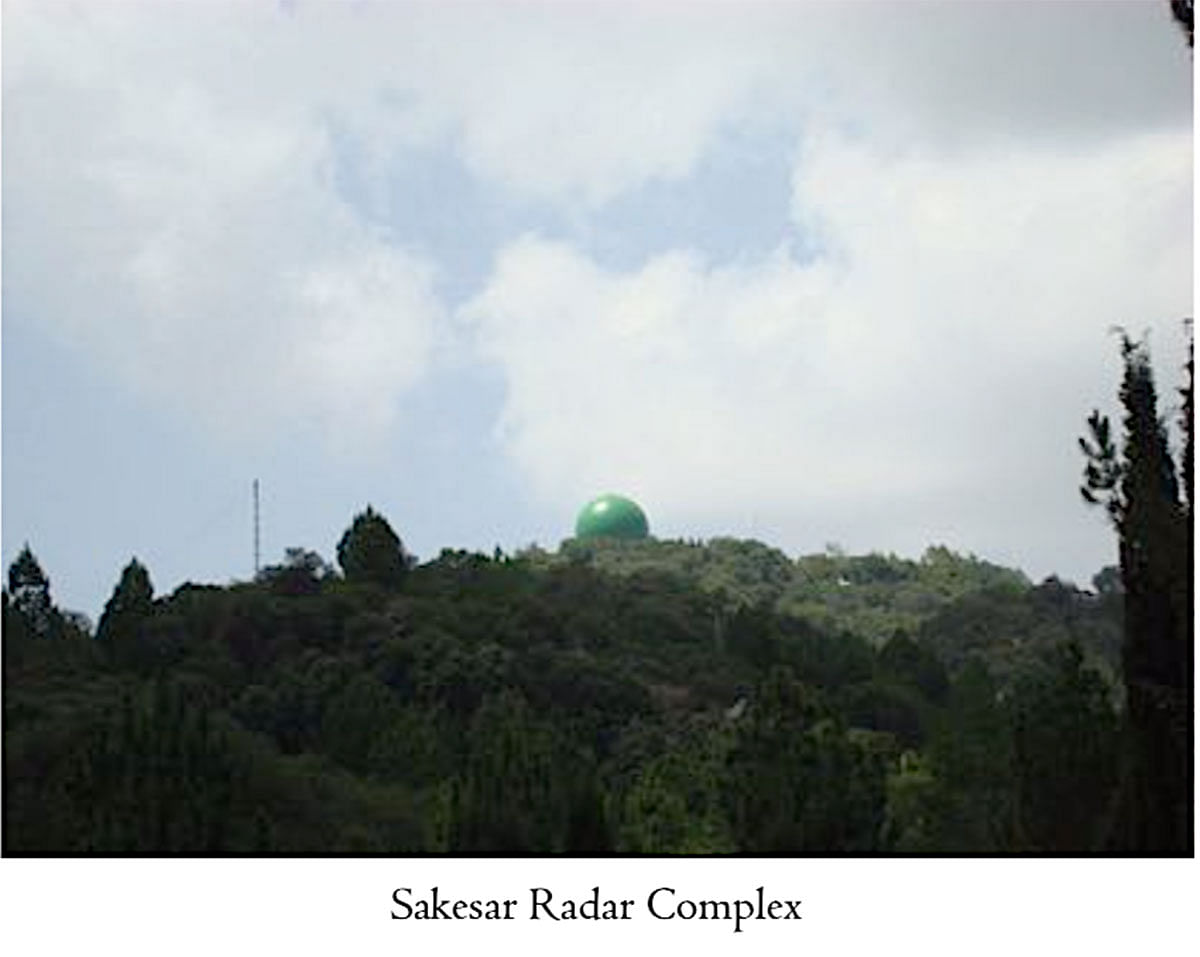
This provided an early warning to the defenders at Sargodha of a minimum of two–five minutes, which was sufficient to take counter action. The base comprised a Sector Operations Centre (SOC) and a GCI element. It passed near real-time data to the PAF base at Sargodha and controlled all airborne interceptions in the region. Early warning to Sargodha base was also available from a mobile 500 KW Type 14 CHEL/GCI radar at Rahwali and from the personnel of PAF’s Mobile Observation Force (MOF), who were spread all along the likely entry points of IAF’s strike elements near the Indo-Pak border.
Sargodha during those days, minus the bases inside the Soviet Union, was probably the most well-defended target across Asia. The PAF knew that with pre-emptive strikes on 6 September, they had stirred a Hornet’s nest and the IAF would strike with vengeance at this most strategic base. However, it was confident, that with an advanced early warning and multi-layered defensive capability, only the most die-hard IAF strike elements would be able to get through to Sargodha. And there they would be blown away to smithereens by the high-density ack-ack.
The PAF had grossly under estimated the tenacity and resolve of the IAF fighter pilots who were ready to absorb a high rate of attrition to hit back at the PAF at Sargodha.
5 Sqn Canberra Strike – 2345H IST
The first IAF bomb to explode over Sargodha was dropped by an IAF Canberra late at night on 6 September itself. Carrying out shallow dive attacks from medium altitude, 5 Sqn Canberras raided the airfield at night but could not cause significant damage. The raid, however, cautioned the PAF to the IAF counter-offensive scheduled for a few hours later.
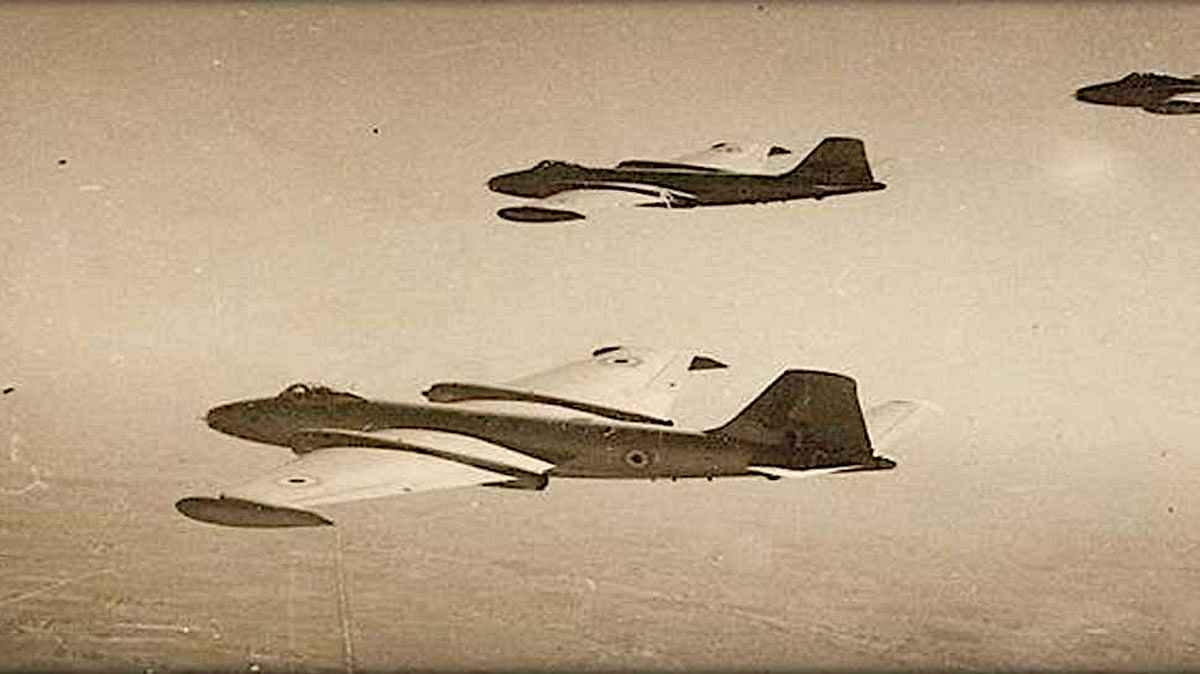
Also read: On this day 54 yrs ago, another IAF hero shot down a vastly superior Pakistani fighter jet
1 Sqn Mystere Strike – 0600H IST
The IAF strike by the ‘Red’ formation, comprising of three Mysteres of 1 Sqn ‘Tigers’, flying out of Adampur, hit Sargodha at 0558h IST. Flying at tree top levels, the ‘Tigers’ were led by their CO, Wing Commander O.P. Taneja in a daring, tree top level navigation in extremely poor visibility conditions. Operating out at the extreme end of their range, the Mysteres had just enough fuel for a single pass attack over their target. The Sakesar Radar picked them when they were two minutes away from Sargodha. Pakistani fighters were vectored towards them.
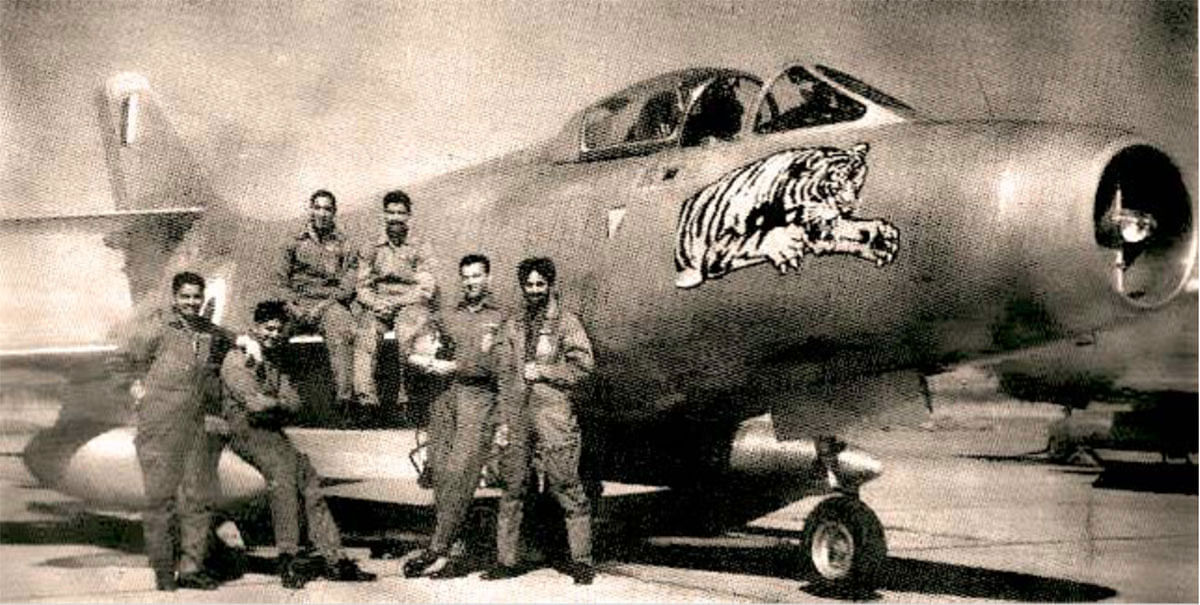
The IAF Mysteres efficiently slipped past the dragnet of the CAP and pulled up over Sargodha for a rocket attack. Through intense ack-ack fire and poor visibility conditions, Taneja picked up a parked C130 on one of the tarmacs and made short work of it with his 68mm SNEB rockets. His No. 2, Flt Lt ‘Frisky’ Verma and No. 3, Sqn Ldr A.B. Devayya, fired their SNEBS at aircraft parked inside the blast pens, but no conclusive evidence of destruction could be seen by them. Taneja, after his pass over the longer runway end, pulled up and spotted a Starfighter and some Sabres on the Operational Readiness Platform (ORP). He informed the 4 aircraft Mystere formation arriving over Sargodha a minute behind them of the same.
Led by Sqn Ldr D.E. Satur, the ‘Pink’ formation consisted of Flight Lieutenants A.K. Brahmawar and J.P. Singh along with Flying Officer S.S. Dange. Satur and his formation went on to attack aircraft parked inside the pens and other targets in the technical area. One Starfighter was positively destroyed and a couple of Sabres were claimed as probable.
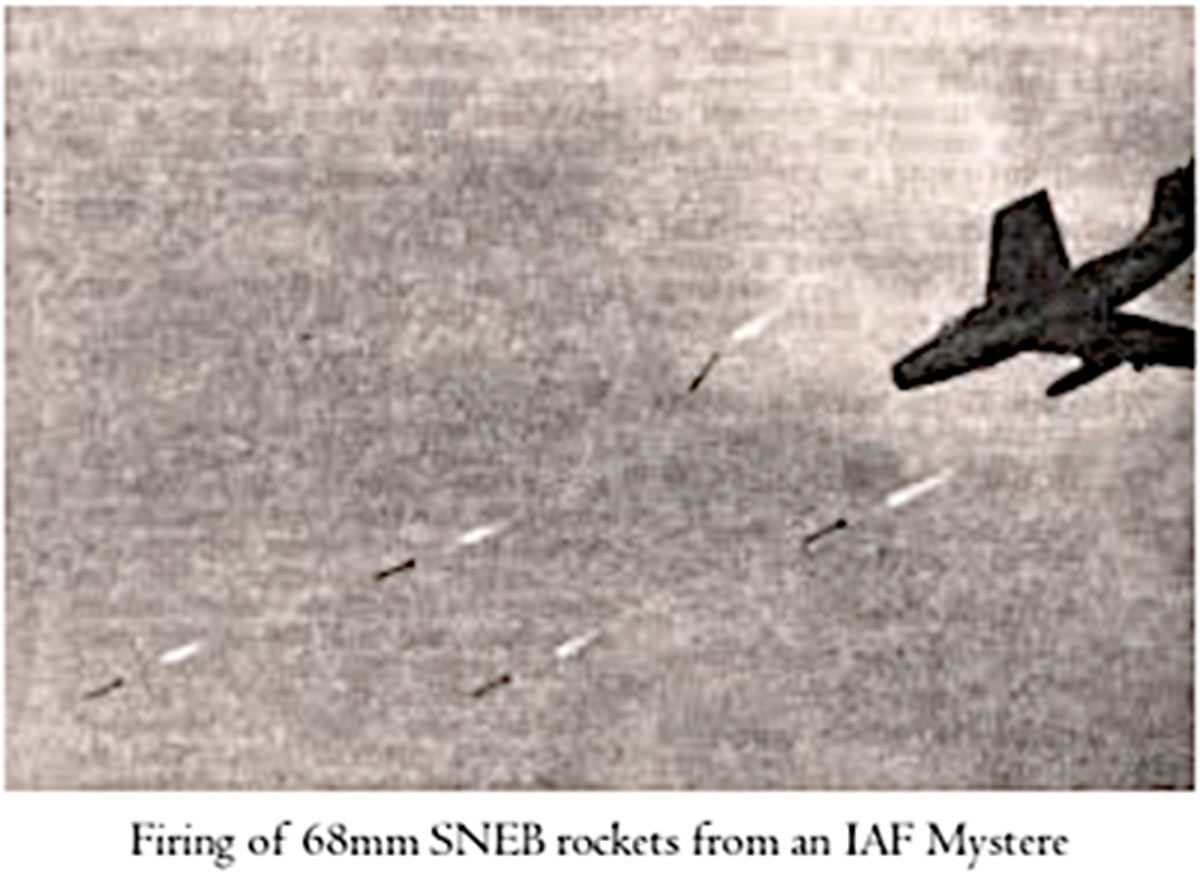
The ‘Red’ and ‘Pink’ formations exited post their attacks. Four Sabres and one Starfighter were vectored to intercept the seven Mysteres. After a hair-raising exit at ultra-low levels, with the fuel needle sliding towards ‘empty’ at a rapid rate, the Mysteres landed back at Adampur.
Sqn Ldr A.B. Devayya was reported missing after it was realised that he had not made it back. The story of Devayya’s unknown heroism at that time, and loss, is covered here.
8 Sqn Mystere Strike – 0603H IST
While the Mysteres of 1 Sqn were raiding Sargodha Main, eight Mysteres of IAF’s 8 Sqn ‘Pursoots’, were striking Bhagtanwala airfield to the east of Sargodha. Indian intelligence had reported the presence of Sabres at Bhagtanwala and the ‘Pursoots’ were there to hunt them down. The leading formation was the ‘Black’ formation led by Sqn Ldr ‘Mickey’ Jatar and had Flight Lieutenants ‘Chopi’ Chopra, Vinod ‘Pat’ Patney and Vinod ‘Jimmy’ Bhatia. Sqn Ldr Godfrey Salins led the second formation of four Mysteres. The eight Mysteres arrived over Bhagtanwala, undetected by Sakesar Radar or the CAP aircraft.
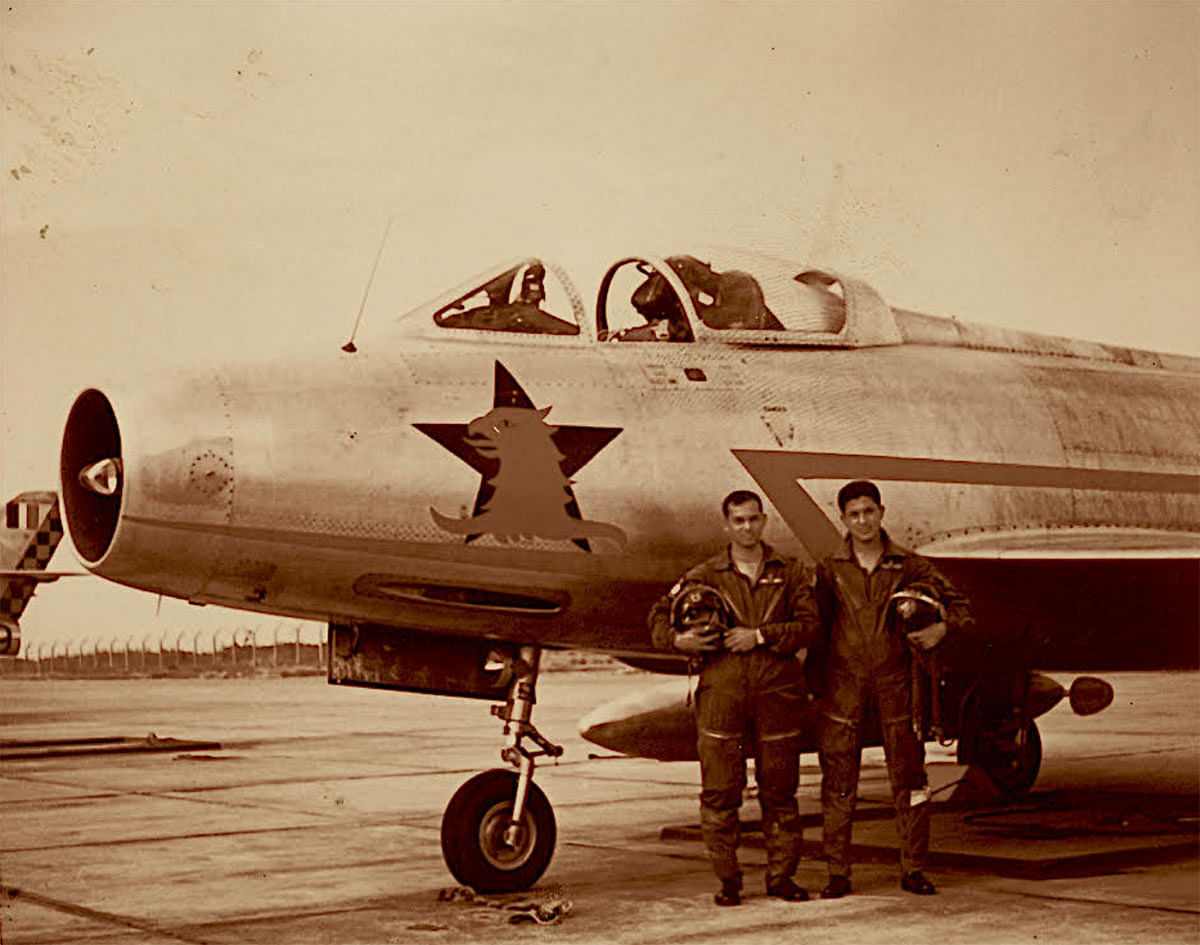
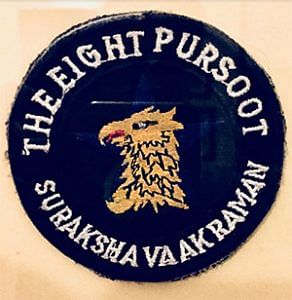
Like the Tigers, the Pursoots also faced poor visibility conditions. The Black formation spotted two Sabres on the ORP and attacked them with their rockets. Both Sabres were destroyed. They made another pass and strafed the airfield and thereafter exited safely back for India. However, it was clear to the formation members that their strike formation could have been better utilized as a follow on attack at the Sargodha main runway.
27 Sqn Hunter strike – 0614H IST
Five low-flying Hunters of 27 Sqn ‘The Flaming Arrows’ operating out of Halwara, targeted Chota Sargodha, west of Sargodha Main. Sqn Ldr D.S. Jog led the raid with Sqn Ldr O.N. ‘Piloo’ Kacker, Flight Lieutenant T.K. Chauduri and Flying Officer P.S. Parihar. Flight Lieutenant D.N. Rathore, who had shot down Rafiqui over Halwara a day earlier, was the lone fighter escort to the leading four Hunters, each armed with T-10 rockets. The intelligence on Chhota Sargodha was faulty.
When the formation pulled up for the attack over Chhota Sargodha, the airfield was found to be devoid of any aircraft. Jog decided to target the Sargodha runway and set course for the same. They arrived over Sargodha at 0617 hours IST. This time, the formation spotted Sabres over the runway, including one of the CAP augmenting formations, which was about to get airborne. The formation targeted them and as well as other targets all over the field with their T-10 rockets. Rathore particularly went after the Sabres who were preparing to take off. He scored multiple hits on them with his 30mm guns. By now the PAF was ‘fully awake’ and the ack-ack gunners were beginning to make life uncomfortable for the IAF. It is believed that Piloo Kacker’s aircraft was hit by anti-aircraft fire sometime over the airfield and the fuel began to gush out of his Hunter.
As the Hunters exited, two PAF Sabres bounced them.
Sqn Ldr MM Alam of the PAF, who was the holding CAP over Sargodha along with his wingman, Flt Lt Masood Akhtar, was vectored by Sargodha’s ‘Killer Control’—the CAP controller, behind the Hunters. Alam made contact with the formation and started to close in rapidly. He fired two Sidewinder AAMs at the rear pair, both of which failed to shoot down the Hunters since they were hugging the ground and the IR lock on the Sidewinders broke in the presence of the large amount of heat bouncing off the ground. By this time, Rathore had spotted Alam, who was closing into gun ranges.
Rathore gave a ‘buster’ tactical action to the formation and turned for Alam. Alam, in the meantime, had closed in to fire his Brownings behind the formation. He fired inconsistently and scored minor hits on Jog’s Hunter, which remained airworthy. His aim was probably distracted by Rathore’s Hunter, which was heading towards him with guns blazing. Alam broke towards Rathore and gave him a head-on cross. Alam’s wingman, Masood Akhtar tried to slot in behind Rathore, whom Rathore easily shook off in a couple of scissors. Alam had lost contact with the extricating Hunters and chose to climb back to medium level out of harm’s way.
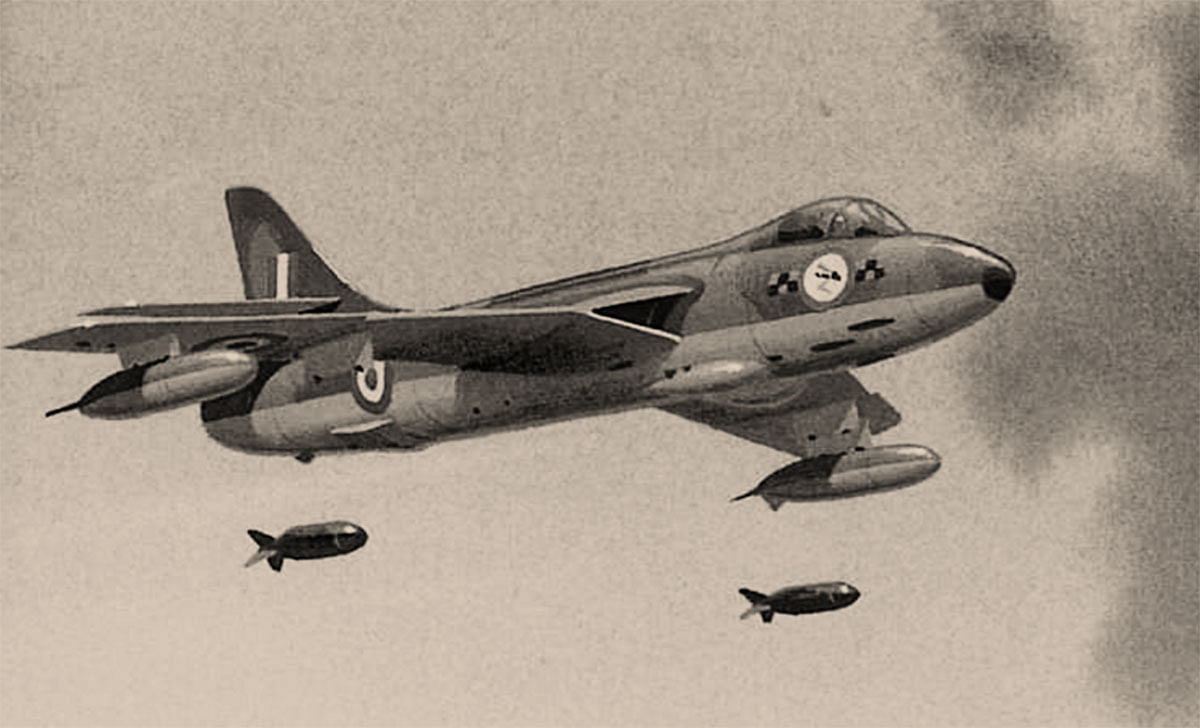
Rathore, after neutralizing the threat from the two Sabres, made contact with the Hunters and Jog and was relieved to see all Hunters unscathed. His relief was short lived as Kacker, whose Hunter had been hit by ack-ack over Sargodha, had to eject when his engine ceased due to fuel starvation. Kacker ejected near Burjlal, a village on the bank of Chenab, about 25 miles south east of Sargodha. He ejected and survived as a POW.
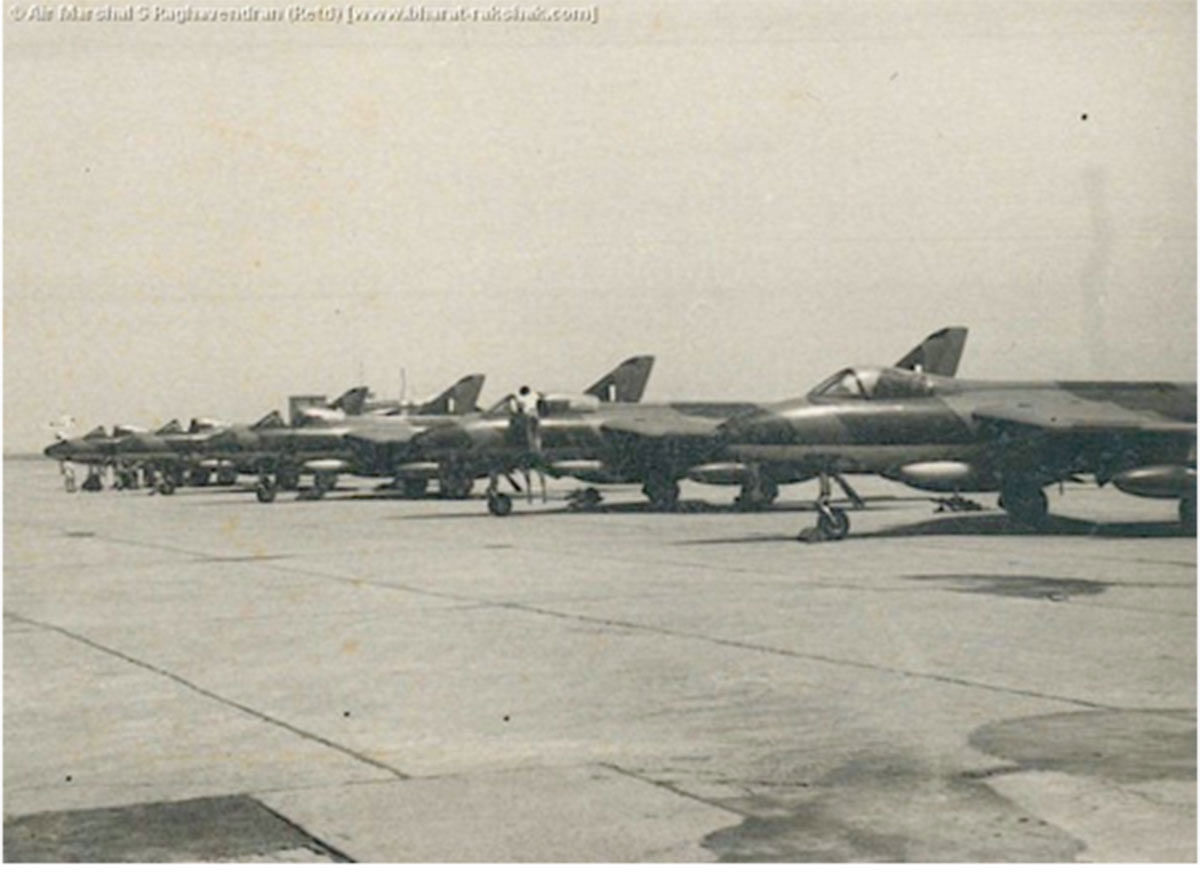
As the four 27 Sqn Hunters hit the deck level, they saw the five Hunters of 7 Sqn ‘The Battleaxes’, on their way to attack Sargodha. Jog realized that they were flying straight towards the waiting Sabres and would be sitting ducks. He called out on R/T, and realized that the 7 Sqn formation was on a different frequency. In those vital few seconds, due an innocuous communication gap between these formations, the four PAF Sabres were able to re-vector successfully for the 7 Sqn Hunters on their way to Sargodha and build up the greatest post war air combat myth of the Indian sub-continent.
Sabres vs 7 Sqn Hunters – 0620H IST
Wing Commander Toric Zachariah, the CO of 7 Sqn, led the three-aircraft strike armed with T-10 rockets. His No. 2 was Sqn Ldr A.S. Lamba and No. 3 was Sqn Ldr M.M. Sinha. Two Hunters made up of Sqn Ldr S.B. Bhagwat and Flying Officer J.S. Brar escorted the ground-attack configured Hunters. Sakesar GCI had picked up the five Hunters and a swarm of PAF fighters was being vectored towards the Hunters. Two Sabres, comprising of Flt Lt Imtiaz Bhatti and his wingman, and a lone Starfighter flown by Flight Lieutenant Arif Iqbal, were heading towards the incoming Hunters.
And then there was also Alam and his wingman, who were prowling closest to the Hunters.
Sinha spotted the two Sabres of Imtiaz Bhatti and his wingman at his 11 o’clock, 4000 feet high at around 6-8 km and ordered a defensive hard turn to the left. All aircraft began to turn left. Zachariah, at this stage, realized that it would not be prudent to continue with the mission and ordered the jettisoning of all stores and abandoning the strike. He rolled out towards India and Lamba joined up with Zachariah to hit the deck level with full power. At this stage, Lamba had lost contact with Sinha and looking back – was appalled to see the escorting Hunters continuing with their turn and not rolling out back towards home.
Apparently, while the Hunters carried out the left hard turn to be safe from Bhatti’s Sabre pair, the unseen Alam and his wingman, who were closer than the other Sabres, were presented with all Hunters turning in the same direction, facilitating Alam’s rapid closure onto the rear pair of Bhagwat and Brar. By the time the two Hunters spotted Alam dropping in, they were sitting ducks and continued turning hard towards Alam in a ‘Rip’ manoeuvre, hoping to somehow spoil his gun solution, which Lamba saw as a continual turn.
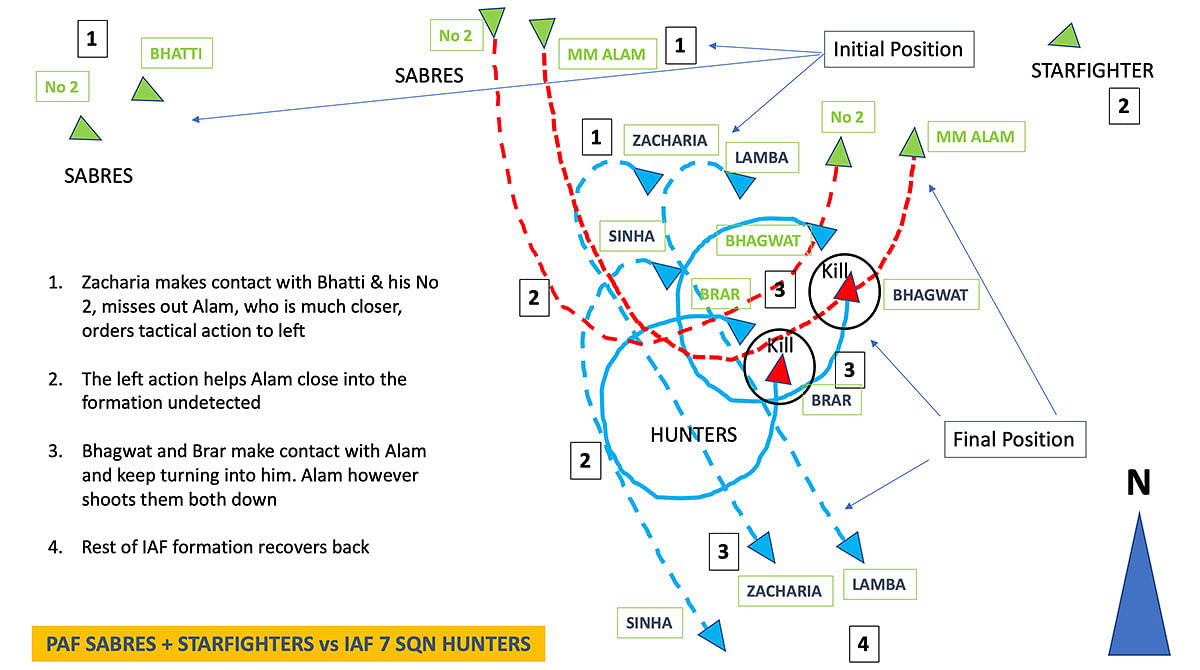
Alam, one of the most qualified pilots in the Sabre fleet, and presented with targets akin to sitting ducks in a firing range, did not slip this time and effortlessly shot down Bhagwat and Brar. The IAF pilots, being at a very low level, could not eject in time and did not survive the crash that took place near the Kirana Hills.
They were the ONLY kills for Alam on that critical day. However, the daft Pakistani propaganda machine working overtime, gave Alam the credit of shooting down five IAF Hunters that day, incredulously within a span of only thirty seconds!
Zachariah and Lamba landed back safely at Halwara and were joined by Sinha, who had landed before them. One IAF Hunter (Piloo Kacker) had been lost to ack-ack and two to PAF Sabres (Alam) during the strikes by the IAF Hunters from Halwara. It is estimated that four Sabres and one Starfighter were vectored towards the Hunter formations. While the home turf advantage and some good luck favoured the PAF defenders, the IAF losses could have been more had it not been for the aggressive manoeuvring by Rathore, who foiled Alam’s attack on his formation.
Also read: 1965 India-Pakistan war: How IAF’s heroes slayed PAF’s superior Sabre fighter jets
1 Sqn Mystere strike – 1010H IST
The most successful raid of the day over Sargodha was carried out by the ‘White’ formation of 1 Sqn comprising of four Mysteres armed with guns, rockets and 1000lb bombs. Sqn Ldr S. Handa led it in broad daylight along with Flight Lieutenants D.S. Brar, D.M.S. Kahai and Flying Officer Philip Rajkumar. Handa’s formation flew at deck level below the prying eyes of the Sakesar Radar.
They were picked up by the PAF mobile observation posts at 1010 hours. Several Sabres and Starfighters were scrambled by the PAF towards the eastern approaches of Sargodha. The Sabres and Starfighters, assisted by the Sakesar GCI looked hard, but Handa and his maverick band slipped through them. The PAF was jolted when Handa pulled up over Sargodha for a medium altitude bomb delivery run. With the sky laced with Bofors and Browning ack-ack ammunition, the Mysteres got down to settling scores with the PAF.
Handa dropped his bomb on a bulk petroleum yard and thereafter destroyed two Sabres on the operational readiness platform. Brar had a bomb hang up issue and he jettisoned his bombs over a couple of aircraft hangars. With much better visibility, the formation could identify the targets with ease and when Kahai released his bombs on another petroleum unit, he spotted a couple of Sabres and a Starfighter on the tarmac. He turned hard at low levels and targeted them with his 30mm DEFA guns. His salvo destroyed the aircraft. Rajkumar fired at some Sabres on the ORP and engaged the Sargodha ATC building.
The foursome exited Sargodha at max power, leaving behind a trail of destruction. All they could see below were carcasses of PAF’s prime war-fighting machines ablaze. At tree top level, the formation carried out a zig-zag exit, which made it next to impossible for the PAF Sabres to settle down behind these mavericks for an attack run. All four aircraft landed safely back at Adampur.
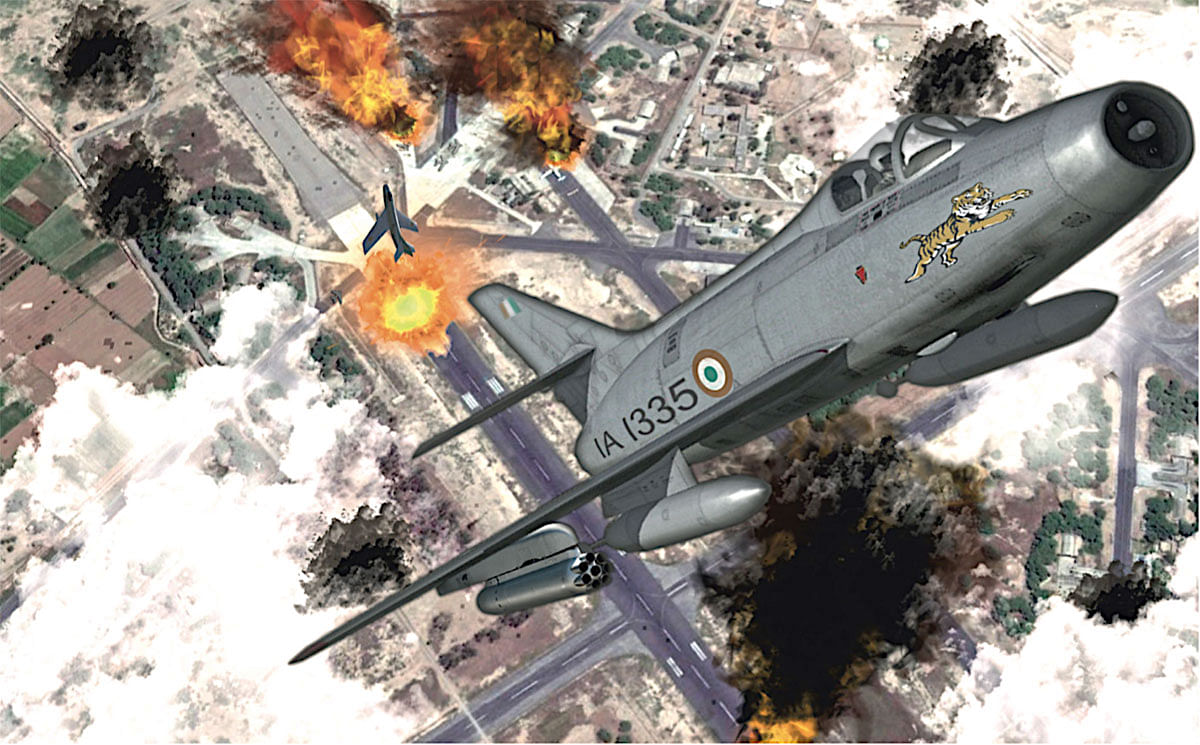
1 Sqn Mystere strike – 1520H IST
A pair of Mysteres of 1 Sqn flew the last mission over Sargodha on 7 September at 1520 hours. Flight Lieutenant J.P. Singh led the raid (his second one of the day) with Flight Lieutenant U.B. Guha as his No. 2. They were armed with SNEB rockets. They navigated at low levels and passed through the outer layer of Sabre CAP. However, the Sargodha CAP controller spotted them. As they were pulling up to attack the airfield, two Sabres dropped behind them. J.P. fired his rockets on the base bomb dump and turned for home. Guha fired his rockets at other targets over the airfield, jettisoned his pods due a hangup and warned J.P. about the Sabres targeting them.
The Mysteres hit the deck, but saw the Sabres closing in and maintaining at around 800 yards behind the formation. Flight Lieutenant A.H. Malik was in the lead PAF Sabre, who had narrowly escaped death on the ORP in the previous raid led by Handa, having seen his Sabre blow up under fire from a Mystere, was vying for revenge. Malik realized that he would not be able to close in more than 800 yards with the escaping Mysteres. He decided to fire his Sidewinder AAMs. With a steady lock on Guha’s Mystere and expertly getting down to the Mystere’s level, Malik fired the first missile. Fired well within its envelope and with a good speed overtake, the missile ran true and exploded on Guha’s Mystere with fatal consequences. Guha perished with his aircraft. Malik then fired the other missile at J.P.’s Mystere but the missile did not hit its target. J.P. managed to outrun the PAF Sabres and land back safely after his high voltage encounter against the missiles. Incidentally, Guha’s Mystere was the first IAF aircraft lost to an air-to-air missile in the 1965 war, unlike false claims by the PAF of before.
A total of 31 strike sorties were flown from dawn to dusk by IAF Mysteres and Hunters against the Sargodha complex. Four IAF aircraft (2 Mysteres and Hunters each) were lost to enemy CAP and one was lost to the anti-aircraft barrage.
One PAF F104 Starfighter was shot down by IAF in air combat.
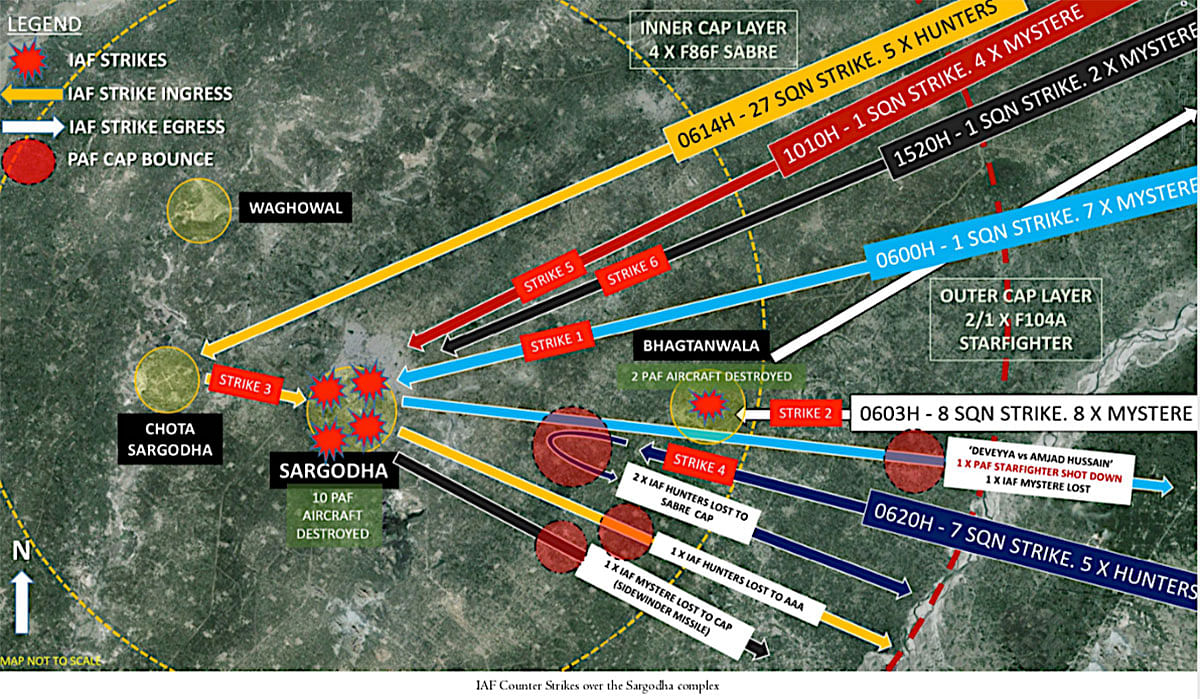
With an aggressive approach, the IAF had penetrated the most well-defended airfield of the PAF and managed to inflict considerable damage at Sargodha. Besides damaging the infrastructure and other assets, ten PAF aircraft including Starfighters, Sabres and a C 130, were destroyed on the ground. The destruction at PAF’s end would have been more, had better intelligence been available with the strike pilots about the relative deployment and spread of the PAF aircraft within the Sargodha complex.
The hard hitting counter-strikes gave satisfaction and confidence to the IAF top brass in the competence of their flight crews. This was the first occasion after independence that the IAF had undertaken dedicated strikes en-masse.
PAF claimed a big victory in the defence of Sargodha. They claimed a total of ten IAF aircraft shot down from dawn to dusk, including the fantastic assertion by Sqn Leader M.M. Alam, in which he claimed to have shot down five IAF Hunters in thirty seconds over Sargodha in a speed-shooting classic.
Alam, without doubt, was a gifted Sabre pilot. However, his was an incredible claim promoted by PAF propaganda over the years and inked in black and white by John Fricker, a British writer, who was commissioned by PAF to write the official history of PAF in the 1965 war. The PAF needed a ‘hero’ to pitch the PAF as a ‘David’ versus the IAF ‘Goliath’, and they created one in Alam. Alam went on to claim ten Indian aircraft during the course of the war.
The IAF and various military historians have debunked this claim adequately over the years and scoffed due this widespread critique, PAF has made efforts to correct this anomaly . Alam has now been accorded three kills on that fateful day in the latest versions of PAF’s history publications. These kills include the loss of ‘Piloo’ Kacker by a Sidewinder missile; who survived to confirm that he had crashed due to fuel starvation after his fuel lines were hit by ack-ack over Sargodha, not by the hand of Alam.
Also the fact that no gun camera footage of Alam’s kills was ever made public by the Pakistani authorities, casts further doubt on the veracity of Alam’s claim.
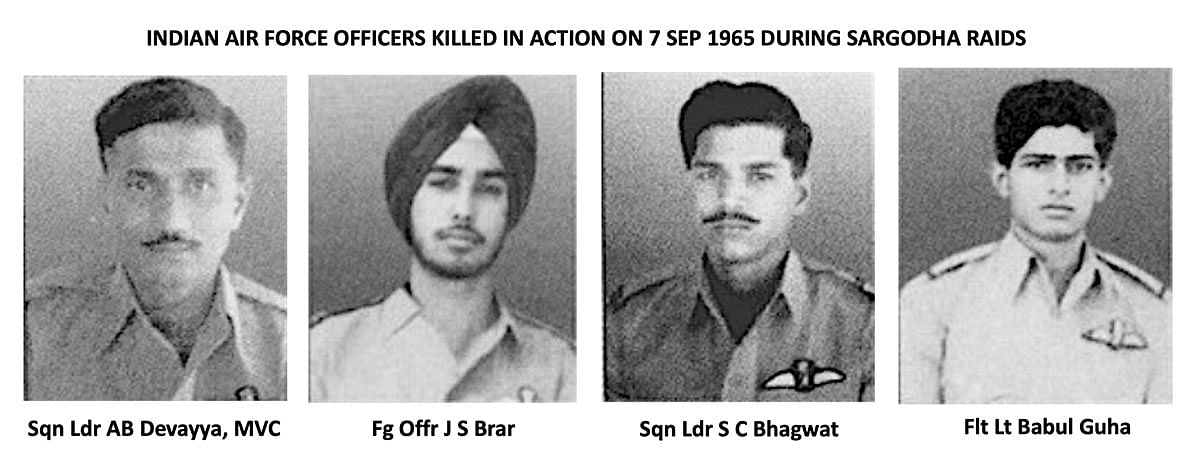
Sqn Ldr AB Devayya’s heroic stand against a Starfighter is the stuff legends are made of. He was awarded a Maha Vir Chakra for his effort and was killed in action. Squadron Leader S. Handa and Flight Lieutenant Kahai were awarded a well-deserved Vir Chakra each for their roles in the most successful strike of the day over Sargodha. They had enabled triumph for the IAF’s ‘tit for tat’ campaign to teach the PAF a lesson deep in its defensive lair.
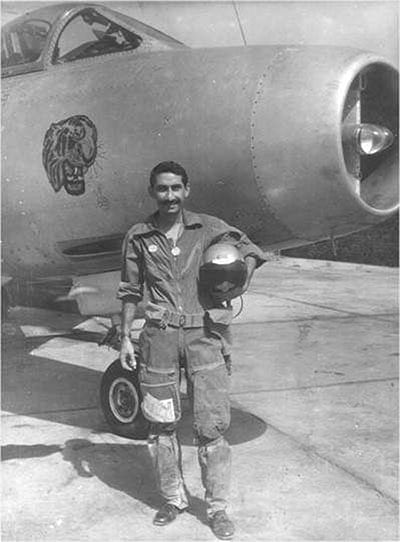
Post these strikes, the PAF tied down a large part of its F-86F Sabre fleet to defend Sargodha and other bases. Hence, the operational effectiveness of the Sabre combat group was reduced to a great extent in the remaining days of the war. This was felt most over the battlefield of Khem Karan in the coming week, where the PAF was conspicuous by its absence. The IAF achieved air superiority over Khem Karan and helped the Indian Army blunt the most ambitious armoured offensive of the Pakistani Army in the 1965 war.
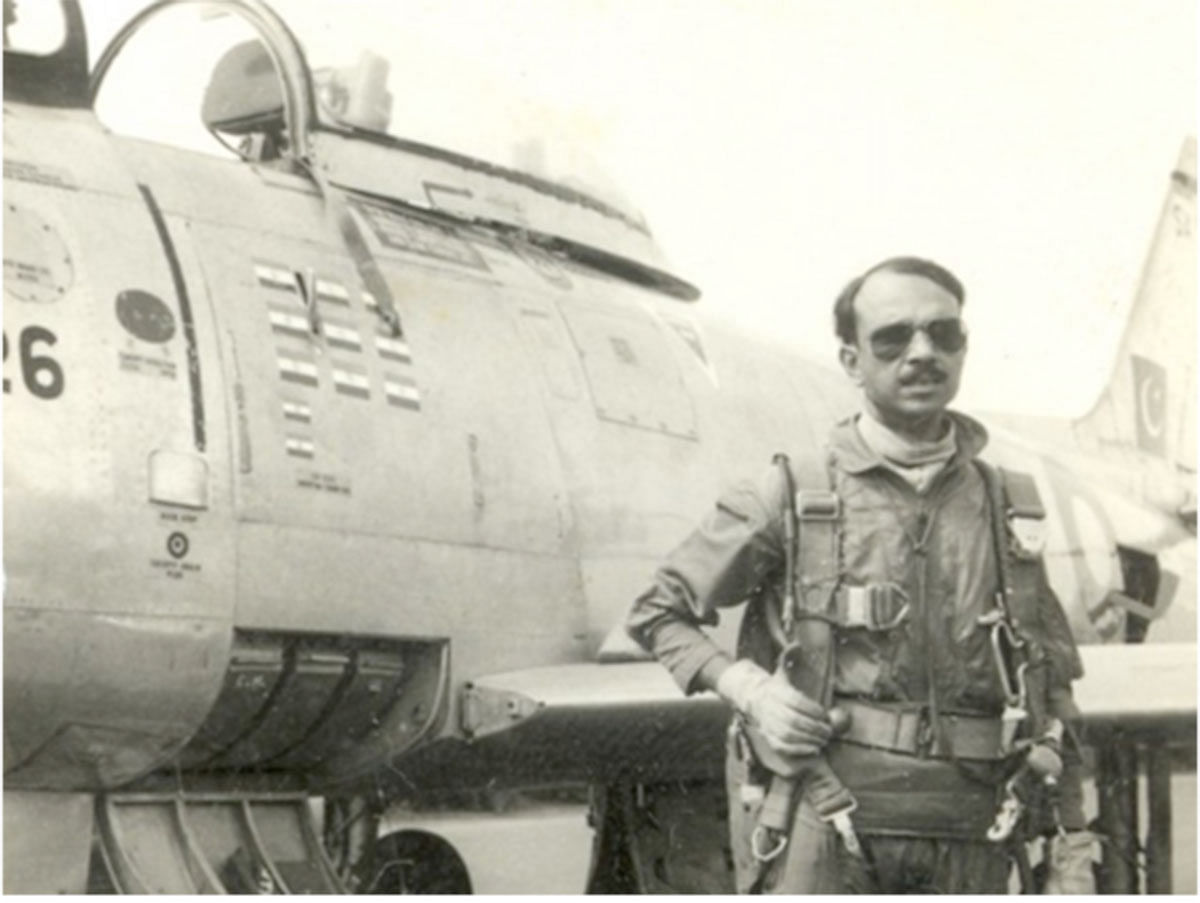
Aftermath – MM Alam and his fall from grace!
A detailed investigation on the farcical nature of MM Alam’s claims, proving that the Pakistan Air Force deliberately lied to portray a larger than life image, has been adequately debunked by a superbly investigated piece by Rakesh Koshy at Bharatrakshak.com. This can be read here.
Alam commanded No.11 Squadron until April 1966. In November 1967, he was promoted to Wing Commander, given the command of No.5 Squadron and charged with overseeing the introduction of the newly imported Dassault Mirage IIIEP into that unit. At about that time, Alam began to have problems as a result of professional jealousies and personal resentments among fellow PAF officers. There were accusations that while Alam was a great pilot, his leadership qualities at the senior officer level left a lot to be desired. As Pakistan’s so called first ace, much was expected of him after the war, and his more limited administrative abilities may have suffered further under the pressure of such expectations.
Alam was also reappraising his lifestyle, reaching the conclusion that the abandonment of traditional Islamic values by the PAF constituted a betrayal of the people it served. The most obvious symbol of that compromise of values was the consumption of alcohol. Alam not only quit drinking but also began trying to persuade his colleagues to banish alcohol from the officers’ mess. Inevitably, Alam’s growing zeal rubbed many PAF officers – a good many of whom were his superiors – the wrong way. In 1969, Alam attended the staff college, but was removed from the course in 1970 under the absurd pretext that he could not ‘read and write’. In May, he was relieved of command of No.5 Squadron – which was given to Wing Commander Hakimullah Khan – and played no active role in the Indo-Pak War of December 1971. Alam was given command of No.26 Squadron in January 1972 but lost it just two months later.
It must have been insulting for Alam to have been removed from staff college in 1970 on the basis that he could not read or write! Even more damaging was his non-active role in 1971, when just six years earlier in 1965, he was on the topgun of the PAF. To be then removed from command of No.26 Squadron just two months after he got it in 1972, must have surely hurt his ego deeply. Alam retired as an Air Commodore in March 1982. He became a devout Muslim, being often described as a mullah who spends his time praying and forecasting condemnation to hell for the PAF Officers who are less devout!
He passed away in 2013. The PAF Airbase Mianwali was renamed after him as PAF Base M.M. Alam in 2014.
Meanwhile, the PAF till date has not acknowledged the actual loss of its aircraft during the IAF strikes on 7 Sep 1965.
Sameer Joshi is a retired Indian Air Force fighter pilot with experience on the MiG-21 and Mirage-2000 jets. Besides being a start-up entrepreneur, he has serious interests in aerospace & defence and military history.
Also read: 8 pieces of clinching evidence that show how IAF’s Abhinandan shot down a Pakistani F-16


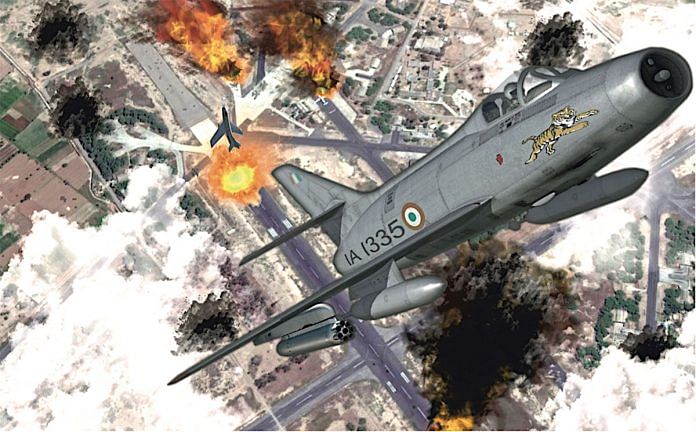

Paf is mach better than iaf m. m alam is over hero 🇵🇰
Why fighting over this । Thanks burki jilla Lahore was photographed by Indian mistake।and in 1971 Pak won the war and their 90000 fouji was only paying a Goodwill missions to India।and still east Pak is with in Pak।and economy of Pak is flourishing। Atta is so cheap in Pak that they are exporting them।what a kind of falsehood speed over Pak।a banana republic controlled by military dictators।
What a propaganda article. Pakistan smashed India in 1965 in fact. If Pakistan did not listen to UN that time., Indian Occupied Kashmir would have been free now. Anyway terrorist India would be defeated again like in 1948 & 1965. This time Kashmir will be free for ever.
Mind your language
A false safe made story,so many technical mistakes, Sargodah was once attacked by IAF but bruttly lost their jets,after next entire war of 17 days thy never come close it,Alam hit 9 indian jets, 5 at single attempt ,world had recognised it,also in this report Alam picture with his Saber is provided, if u magnified it there is 9 indian flage on it,once attack was from Dwarka to Karachi was done but next day PAKISTAN NAVY attacked on it and wiped out Dawarka. For ever.
Comment from Achilles Posted in ThePrint: 10.09.2019
Good graphics and visual presentations, but unfortunately full of serious and plainly wrong statements. Both India and Pakistan are following the same trend in school-level syllabi books as well, doing utmost harm to the self-esteem of our girls and boys, because when they reach adulthood and discover the truth, they will traumatically lose respect for their elders and their countries. Defence writers in both countries (already grown up) should try and reverse this trend, for the sake of future generations of officers.
This writer was a senior fighter pilot and flew an average of two sorties every day from Sargodha (BTW the air base runways remained operational throughout the 23 days of war). I saw the Mystere and Hunter attacks on 6-7 September. Both pilot groups fired from very shallow dive angles and many fired while still in diving turns or while hurriedly shifting their sights to targets they had seen too late. Because most pilots chose 10-15 degree dives, Sargodha’s heavy tree camouflage had obviously obscured from their view all the penned aircraft. But our ORP was without cover, and there was no reason why the Hunters and Mysteres should have missed those easy targets (We gave up the ORP idea in a hurry).
During the 6-7 September campaign, only ONE F-86 was destroyed. And NO F-104 was even scratched. Additionally, NO (repeat) NO other aircraft of any type was destroyed or damaged by the IAF Canberras or day fighters during the remainder of the war.
I say again, it is best to stick with the truth. This is good for our Crew Room pride, where both the IAF and the PAF strive to nurture good officers and pilots.
Achilles
So you think you fools of 1 billion believes in these lies ? Lol we show you how we respond on 28 Feb , we show you how we invade 300 years ago , we show you how we Break in 1947 , 1971(you think this is your win no this is the win of Muslims they got another country from India ) , This is how we do the math
1971(you think this is your win no this is the win of Muslims they got another country from India )
lol .. How about we give you more countries in form of balochistan, punjab etc ? 😀 sorry couldnt resist. If you calmly anaylyse your own statment you will realise the leel of stupidity amongst pakistani ‘awam’…no wonder whole world makes fun of pakistan.
You Bindians are still following the abjact lies of your false claims from65. tilll today
Bindians maybe wrong word. I would rather use Randians.
Comment from Achilles Posted in ThePrint: 10.09.2019
Good graphics and visual presentations, but unfortunately full of serious and plainly wrong statements. Both India and Pakistan are following the same trend in school-level syllabi books as well, doing utmost harm to the self-esteem of our girls and boys, because when they reach adulthood and discover the truth, they will traumatically lose respect for their elders and their countries. Defence writers in both countries (already grown up) should try and reverse this trend, for the sake of future generations of officers.
This writer was a senior fighter pilot and flew an average of two sorties every day from Sargodha (BTW the air base runways remained operational throughout the 23 days of war). I saw the Mystere and Hunter attacks on 6-7 September. Both pilot groups fired from very shallow dive angles and many fired while still in diving turns or while hurriedly shifting their sights to targets they had seen too late. Because most pilots chose 10-15 degree dives, Sargodha’s heavy tree camouflage had obviously obscured from their view all the penned aircraft. But our ORP was without cover, and there was no reason why the Hunters and Mysteres should have missed those easy targets (We gave up the ORP idea in a hurry).
Throughout the 6-7 September campaign, only >>ONE<>NO<>NO<< (repeat) NO other aircraft of any type was destroyed or damaged by the IAF Canberras or fighters during the remainder of the war.
I say again, it is best to stick with the truth. It is good for our Crew Room pride, where we nurture good pilots.
Achilles
Dear Mr Editor,
The fourth paragraph should have read:
“Throughout the 6-7 September air-to-ground attacks, only ONE F-86 was destroyed. No (repeat) NO aircraft of any other type was destroyed or damaged on the ground at Sargodha by the IAF’s Canberra or fighter attacks throughout the remainder of the war.”
Kindly have the text amended as shown.
Many thanks.
Achilles
hahahahahahahahhahaha
i cant stop laughing after reading this post.
each and every paragraph is pack of lies and nothing more.
They print what Indians want to read
Brave men. Living and dying for their country. Wonderfully written.
Thank you Sir.
If you wish a new topic, may I suggest a topic of Pakistani Air raid at Kalaikunda in West Bengal. I have suggested a few earlier also.
https://theprint.in/opinion/heroics-of-1965-war-an-indian-air-force-pilot-engaged-four-pakistani-sabre-jets-all-alone/234459/
Dear Sameer Joshi – Thank you. When are you putting all your articles in form of a published book? Please do. Cheers.
First of all I pay homage to all gallant air warriors who fought tenaciously for their countries.
Secondly, Exaggerations aside, will the author please provide a reference to 10 aircrafts destroyed at Sargodha from a credible research based sources? Would like a research of any of the famous Indian Air War/Aviation historians.
Thank you Sameer Joshi for the well researched hair raising encounters of the ’65 IAF Gallant Warriors.
A great Read.Salute to the Heroes.